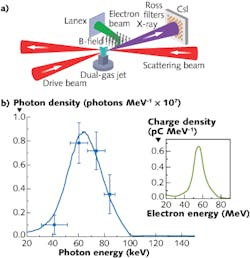Because the maximum achievable photon energy for compact Compton-scattering x-ray sources is currently limited by the maximum permissible field gradient of conventional electron accelerators, the radio-frequency (RF)-driven x-ray source at Livermore National Laboratory (LLNL; Livermore, CA), for example, produces 478 keV x-ray beams with 12% spectral bandwidth, 16 ps temporal duration with a flux of 1 × 105 photons per shot, for a 1.5 × 1015 photons/s-mm2-mrad2 peak brilliance (per 0.1% bandwidth). But by instead using a compact, all-optical laser wakefield accelerator (LWFA), researchers at the University of Nebraska-Lincoln (Lincoln, NE) can produce quasi-monoenergetic (<50% full width half maximum or FWHM), tunable x-rays that are a thousand times brighter with 10 times more photons per shot than conventional RF-driven sources.1
The phenomenal brightness increase is made possible using the 100 TW, 800 nm Diocles laser at the University of Nebraska-Lincoln with femtosecond pulse duration to enable micrometer-scale transverse sizes of LWFA electron beams and correspondingly bright and compact x-ray beams with narrow bandwidth and tunability from approximately 70 keV to greater than 1 MeV.
Laser-driven x-ray generation
After passing through a beamsplitter, one beam of the 1.3–1.7 J Diocles laser drives the LWFA while the other is spatiotemporally overlapped with the electron beam 1.5 mm downstream from the LWFA exit at a 170° (almost directly backscattered) angle (see figure).
X-rays were detected with a 40 × 40 voxel array of 1-mm-square, 1-cm-deep cesium iodide (CsI) crystals imaged with an electron-multiplying CCD (EMCCD) camera. Ross filters were cut into 1.2 mm squares and aligned to single detector voxels; x-ray beam profiles were reconstructed by a 3D spline interpolation and transmittance maps were produced by dividing the measured signal by the reconstructed one. The signal differences between the two filters of each Ross pair were used to calculate the number of photons within the measurement bandwidth of that pair, leading to a spectral profile.
From the tabletop-sized accelerator, x-ray beams had high brightness of 3 × 1018 photons/s-mm2-mrad2 for 70 keV beams and 1 × 1019 photons/s-mm2-mrad2 for 1 MeV beams. Measurements using Ross filters contained within 4.5 mrad of the beam center revealed that the x-ray spectrum was centered at 66 ±7 keV with an energy spread of approximately 50% FWHM, fitted with a Gaussian profile, which is peaked (rather than exponentially decaying with increasing energy as in other laser-driven Compton sources) and thus having far fewer low-energy photons.
The high-energy, truck- or room-sized attributes of this laser-driven Compton source are valuable for applications in ultrafast radiography and deployable nuclear detection. “We believe that our miniaturized laser-driven Compton x-ray source has important commercial and research applications,” says project leader Donald Umstadter, professor of physics at University of Nebraska-Lincoln. “It will improve x-ray radiography, which impacts medical diagnostics, nondestructive evaluation (detection of hairline cracks in turbine blades), and shielded interrogation for special nuclear materials.”
Umstadter adds, “Research with this new source can also improve our fundamental understanding of the interactions of intense light with electrons. In future experiments, we intend to investigate Compton scattering at ultrahigh laser intensities. This will test several theories of current interest, including nonlinear Compton scattering, the radiation reaction force, and astrophysical jets.”
REFERENCE
1. N. D. Powers et al., Nat. Photon. online (November 24, 2013); see http://bit.ly/1frH3wK.

